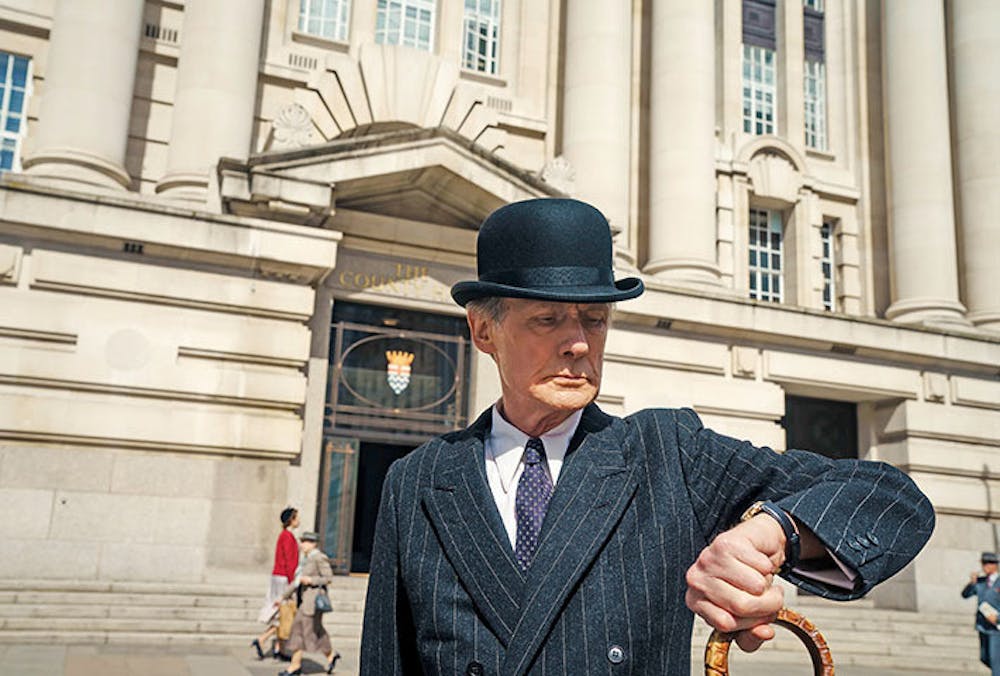Bill Nighy provides a compelling portrait of a dying bureaucrat in Oliver Hermanus’s 2022 film “Living.” After receiving a terminal cancer diagnosis, Rodney Williams (Nighy) sets out to spend the last months of his life with purpose. But while well-acted and heartwarming, “Living” fails to make a substantial impression on the viewer.
The film’s screenplay was written by Nobel Prize-winning novelist Kazuo Ishiguro as an loose adaptation of Akira Kurosawa’s 1952 film “Ikiru,” a work acclaimed for its philosophical tone and brilliant storytelling. Set in post-World War II Britain instead of Japan, “Living” takes on a different tone than that of “Ikiru.”
In the office of the London Public Works Department, papers pile high. Stacks of files atop the desks of Williams and his coworkers serve as barriers that separate the employees from each other, discouraging socialization and boxing everyone in. But despite the atmosphere of professionalism that the papers convey, the office is unproductive. Ironically, this inactivity is spearheaded by Williams himself. At the start of “Living,” it is made apparent that there is no joy to be found in working a bureaucratic civil service job. It is drab, dark and void of passion.
The office’s lack of productivity is made especially apparent when a group of women petition the city to repurpose an abandoned lot into a new community playground. After requesting to speak with Williams about the subject, the petitioners are directed to several different offices before being sent back to him. As it turns out, their proposal does, in fact, fall under William’s jurisdiction. He shrugs off their request, filing their petition randomly amongst his tall stack.
These passionless scenes of bureaucratic life contribute a sense of monotony to the first half of the film. This impression is aided by the film’s cinematography — shot by Jamie Ramsay — which carefully arranges shots capturing masses of pedestrians inhabiting urban landscapes. In one shot, a static camera is placed low to the ground, tracking the footsteps of passersby as they walk quickly along the road. Another shot captures a spiral stairwell crowded with well-dressed professionals. The spiraling staircase — and the performative urgency of those who climb it — symbolizes the monotony of daily bureaucratic life. The speed of those moving within the frame contrasts with the lethargy of Williams’s civil service office. The audience is left with an unsettling question: What is the purpose of this urgency if nothing is getting done?
Williams comes to recognize this absurdity after receiving his cancer diagnosis. Wallowing in existential dread, he questions how to live the rest of his life to its fullest. Unfulfilled after a night of heavy drinking with a local youngster, he goes about processing his mortality by confiding in a young female coworker, Margaret Harris (Aimee Lou Wood). She brings a lighthearted enthusiasm to the office, an energy that Williams admires. He learns from her exuberance and ability to see the best in quotidian realities.
After an abrupt work hiatus, Williams returns to the office with newfound vitality. He ardently works against the sluggishness of bureaucracy to build the playground proposed by the women at the start of the film. In the end, it is his diagnosis that inspires him to live a life with purpose and vigor — one that would be remembered fondly. His newfound passion has brought him happiness.
But the way he achieves this happiness — still within the confines of bureaucracy — feels didactic. Maintaining the workplace as the central means through which Williams is able to achieve happiness takes away from the potential of a more universal, less productivity-focused message of the film.
The message of the story — that the joy of life is found within little moments and pursuits of passion — is nice, but ultimately forces the film to take on an overly sentimental tone that keeps it from moving beyond surface-level. It is comforting to think that one is in control of their legacy, as Williams is in his final moments. But the film’s predictability undermines the impact that this message has on viewers. Unfortunately, “Living” does not provide much beyond these heartwarming lessons.





